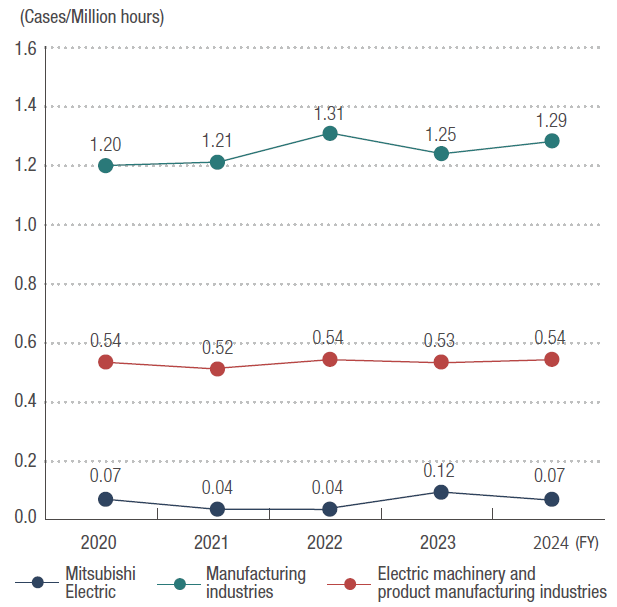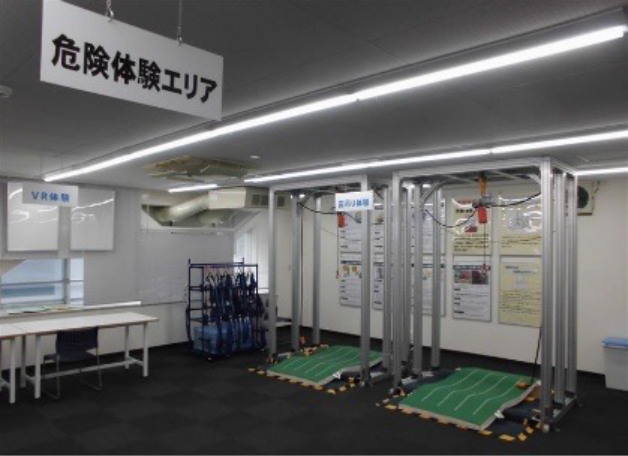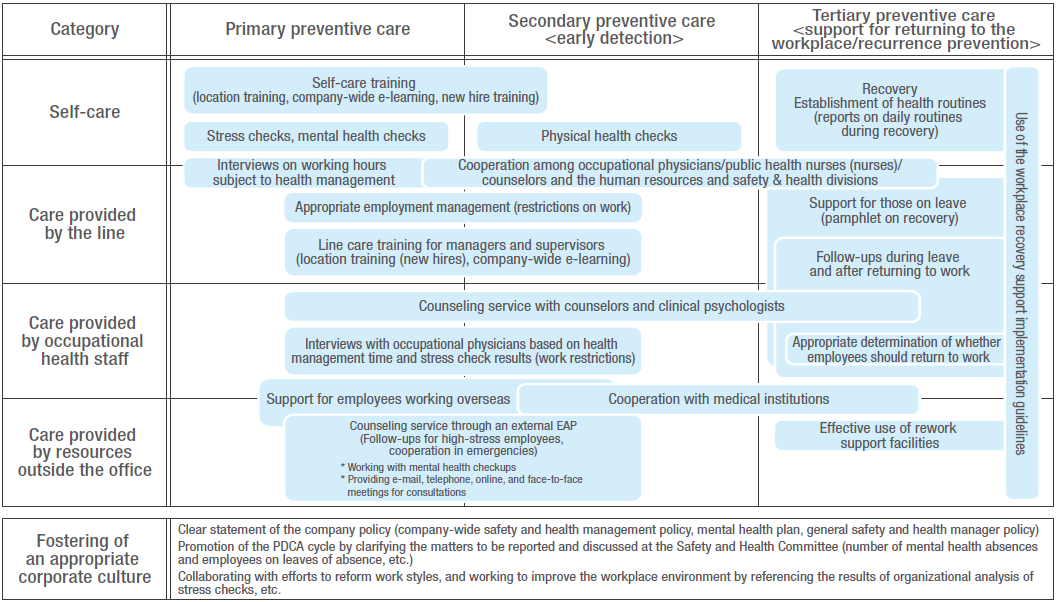Occupational Safety and Health
Basic Policy
The Mitsubishi Electric Group promotes safety and health activities across the entire Group under the strong leadership of the top management.
Adhering to the basic policy of prioritizing the safety and health of our employees above all else, the Group aims to achieve the following two goals.
- Establish a culture that places top priority on safety and health in all social and business environments based on the understanding that health and safety management form the foundation of business management.
- Establish health and productivity management and create a workplace environment that allows everyone to maintain good health both mentally and physically and thrive in work as one of our core management policies for increasing employee engagement.
Based on these policies, Mitsubishi Electric has formulated a company-wide Safety and Health Five-Year Plan and promotes specific activities each fiscal year. Our associated companies in and outside of Japan engage in health and safety management activities in line with relevant laws, national regulations, and company-specific issues, guided by a company-wide safety and health management policy.
Promotional Framework

Company-wide safety and health management framework
The Mitsubishi Electric Group and its associated companies in and outside of Japan cooperate in exchanging information about safety and health, engage in education activities, and implement various measures. Communication is also held with employees through meetings with labor unions and the Safety and Health Committee, and labor management efforts are made to raise the level of safety and health.
Occupational Health and Safety Management System
In 2009, Mitsubishi Electric introduced the Occupational Health and Safety Management System (OHSMS). Under the program, each office runs PDCA cycles for safety and health activities by implementing internal audits based on the Mitsubishi Electric Group’s requirements for safety and health management on foundation management and items to be individually managed. These requirements range from the development of policy and management frameworks in each office governed by a general safety and health manager (assumed by Group Vice President) to the implementation of risk assessment and other accident prevention activities through education to improve employee awareness of safety and health management. The goal is to raise the occupational health and safety management level of the company as a whole. Some of our offices have already obtained the JISQ45001 certificate.
As a result of these initiatives, we have achieved one of the lowest frequency rates and severity rates of industrial accidents (number of people killed or injured in a fatal accident or an accident that requires time off from work per 1 million hours of work, and number of working days lost per 1,000 hours) in the industry.
Risk Management
Mitsubishi Electric identifies hazards through risk assessment and implements risk reduction measures in the following cases.

Frequency of labor accidents (Number of accidents requiring a leave, per million hours)
When new equipment is installed and when equipment is changed
When there is new work or a change in work
For work involving the handling of chemical substances
If an industrial accident occurs, safety measures are immediately taken by the department where the accident occurred. At the same time, efforts are made to prevent similar accidents by conducting safety management status inspections and sharing countermeasures within the Mitsubishi Electric Group developed through case reports of disasters.
Thorough Safety and Health Education
The Mitsubishi Electric Group implements safety and health education that matches its business characteristics and social environment, including stratified programs and occupation specific programs, in addition to education programs as stipulated by law.
As a common feature of the Group, Mitsubishi Electric and its associated companies in Japan also provide safety and health education based on an internal e-learning system, which has been instrumental in promoting greater understanding of the principles and concept of safety and health to more than 100,000 employees, managers, and supervisors every year. Furthermore, efforts are also made to strengthen employee safety education through risk simulation, such as by installing a “safety room.”
Topics
Safety Room at Mitsubishi Electric Kobe Works and Energy Systems Center

Safety room
Mitsubishi Electric Kobe Works and Energy Systems Center provide safety education that includes danger simulation for all onsite employees (approximately 5,000), including those of associated companies, under the slogan “Safety and health first! Building a culture that prioritizes safety and health in everything we do” (Kobe Works) and “Ensuring uncompromising safety and health measures to protect our colleagues” (Energy Systems Center). These business sites have been working to increase all employees’ hazard awareness by upgrading the simulation machine, introducing a virtual reality (VR) simulator, developing and providing education to instructors, and establishing an education system.
Group-Wide Health Promotion Activities
Since 2002, Mitsubishi Electric and its associated companies in Japan have carried out the Mitsubishi Electric Group Health Plan 21 (MHP21) intended for our 100,000-some employees and their families, as a three-party cooperation project (Collaborative Health) with the labor union and health insurance society for 20 years, in an attempt to promote a review of lifestyle habits from an early stage, as a means for preventing lifestyle-related diseases and thereby improving Quality of Life (QOL), and for realizing a “health-oriented company.”
In fiscal 2023, MHP21 was renamed the “Mitsubishi Electric Group Health Management Plan” and another five-year activity has started as “MHP ‘Lively and Exciting Action.’” Under the activity principle, “We promote fitness activities for each one of us to be excited to spend time in a lively way,” we are developing activities with the ultimate goal of achieving a subjective feeling of liveliness and excitement; that is, improved health satisfaction among each and every employee as well as their family members.
Specifically, we have set “good appetite,” “good sleep,” and “good bowel movements” as three indexes to represent the daily level of health satisfaction (degree of liveliness and excitement) regarding the mental and physical health among each and every one of us, for the purpose of assessing the degree of achievement of the activity principle and objective. In addition, we have set “diet” “exercise” “smoking” “care for the teeth” “sleep” and “drinking” as six indexes for lifestyle habits. We utilize these indexes in a system that is designed to visualize each person’s health condition using ICT and other technologies, and that sets targets to encourage changes in behavior according to individual lifestyle habits. In this way, we have been promoting activities that lead to improved health satisfaction.
Our associated companies overseas are likewise taking initiatives to maintain and promote health among their employees, in consideration of the health situation in their respective countries.
MHP “Lively and Exciting Action” activity goals and achievements <Health satisfaction>
| Target item | Target value (by FY2027) | FY2024 result | |
|---|---|---|---|
| Good appetite | Percentage of people who have an appetite and enjoy their meals | 90.0% or more | 88.2% |
| Good sleep | Percentage of people sleeping comfortably and soundly | 80.0% or more | 55.9% |
| Good bowel movements | Percentage of people with good bowel movements that leave them feeling comfortable | 80.0% or more | 65.5% |
Promoting Mental Health Care
Mental health care is a top priority for health management in the Mitsubishi Electric Group. By establishing a counseling program that includes an industrial physician and/or counselor and other such initiatives, active efforts are made to help employees cope with everyday worries related to work and family and other emotional issues.
Through conventional telephone and e-mail counseling and a newly introduced face-to-face counseling program as well as an online counseling program provided by an employee assistance program (EAP),* which covers associated companies in Japan as well, we have actively worked on the primary prevention of employee mental health disorders.
In addition to checking issues related to mental health and formulating a Mental Health Development Plan, the Office Safety and Health Committee (Committee to Promote Mental Health) serves as a forum for collaboration among employees in charge of developing office policies and conducting measures. By disclosing through the Committee information such as the presence or absence of employees who had an injury/sick leave or absences due to mental health, the status of implementation of measures to ensure health and welfare (the number of people eligible for long-term counseling, etc.), and the plans for and results of mental health-related training programs, continuous improvement activities are promoted.
With regard to a stress check system in line with legislation, efforts are being made to improve the workplace climate of organizations with issues in light of the results of organizational analysis.
Furthermore, by conducting stress checks and appointing dedicated counselors in the Mitsubishi Electric Head Office, focused care is also provided to employees posted outside of Japan, where working and living environments largely differ from Japan.
In terms of education, line-care and self-care training are repeatedly implemented through lectures, to provide sessions on mental health and strengthen responses to mental health among managers and employees, especially for mental health. As a common feature of the Group, Mitsubishi Electric and its associated companies in Japan also provide safety and health education based on an internal e-learning system, which has been instrumental in promoting greater understanding of mental healthcare (line-care, self-care) to more than 100,000 employees, managers, and supervisors every year.
- Employee assistance program (EAP) is a program that provides support to employees, by providing a wide range of counseling covering physical health, relationships with family and colleagues, as well as mental health.
 Mental health initiatives (Mitsubishi Electric)
Mental health initiatives (Mitsubishi Electric)
Creating Comfortable Workplace Environments
The Mitsubishi Electric Group recognizes that employees spend a large part of their lives at their workplaces and is committed to creating a comfortable work environment where everyone can work actively, including senior workers and people with disabilities.
By establishing internal workplace environment standards for air and barrier-free facilities, and by working to achieve each standard, Mitsubishi Electric aims to create comfortable workplace environments.
